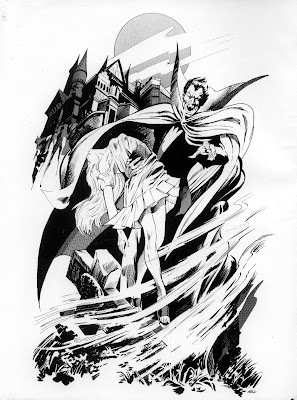Writer: Roy Thomas, based on Bram Stoker's novel "Dracula"
Artist: Dick Giordano
Rating: Ten of Ten Stars
In the early 1970s, Marvel Comics augmented their flagging superhero comics by doing horror "The Marvel Way."
Th Marvel horror boom was kicked off by a series that saw Dracula return to 1970s England in "Tomb of Dracula", and the King of Vampires remained a corner stone of the Marvel horror boom until it it became a bust during the early 1980s. At the height of his popularity with Marvel readers, Dracula headlined three different comic magazines ("Tomb of Dracula", "Giant-Sized Dracula", and "Dracula Lives") serving simultaneously as the hero and villain of some of the darkest tales Marvel Comics ever published, while making guest appearances not only in some of the other horror titles (including an outright cross-over with "Werewolf By Night"), but even facing off with Spider-Man and Dr. Strange.
One of the most interesting and classy initiatives that Marvel Comics undertook with Dracula as an ambitious adaptation of the novel that gave birth to the character their creative staff had so adeptly taken over and made their own, Bram Stoker's "Dracula".
With Roy Thomas adapting the novel and Dick Giordano handling the art, the series was an anchor serial in the "Dracula Lives" magazine, and its perhaps the most faithful comic adaptation of the novel ever published. The creators stay true to both the intent and storyline of Bram Stoker while successfully highlighting those parts of the book that lend themselves to a graphic media. The result are comics that truly were mature more than a decade before the industry decided to market comic books as such.
Unfortunately, Thomas and Giordano were not able to finish their adaption. The height of the popularity of Marvel's horror titles began to wane, and "Dracula Lives" was cancelled. A few more installments appeared in "Vampire Tales", which was then cancelled, and then "Legion of Monsters". But the adaptation remained unfinished.
But Thomas and Giordano, both of whom had great affection for Stoker's original novel, talked together many times of finding a way to finish their work, including buying the original material produced for Marvel and self-publishing. The busy careers of successful writers and artists being what they are, these idle speculations never became anything but that... until Marvel Comics approached the men about finishing what they had started.
Thirty years after it had been begun, Thomas and Giordano reunited and completed the "Dracula" adaptation. In 2004, Marvel Comics reprinted the original chapters and followed them by the roughly 100 pages of new material in a four issue mini-series, keeping all of it glorious black-and-white--or, rather, shades of gray, because Giordano makes skillful use of ink-washes and occasional subtle application of zip-a-tone throughout.
Since Thomas and Giordano had originally envisioned their adaptation as being collected in a single volume once it had been completed, the hardcover collection that Marvel published in 2005 reads far more smoothly than most other volumes made up of stories originally presented in smaller chunks. There's no recapping of what just happened two pages ago, and the pacing from the original novel is retained. In every way, the hardcover of "Stoker's Dracula" is a perfect translation of the novel to comic book form. And the hardcover book, complete with a simple, tasteful dust-jacket and bookmark, gives it the classy packaging it deserves.
It's actually hard to tell that Thomas and Giordano didn't create the material specifically for this book format. It's almost as hard to tell that three decades passed between Giordano's first and last brush strokes. If you look carefully, you can tell--some pages have slightly thicker black borders at the bottom (where there once were "to be continued"-type tags, while the lettering on the last 100 pages is slightly larger and more legible than on the first 100 because it was produced for the comic-book-sized page rather than a magazine-sized one. Another tell-tale sign of the span between start and finish is that Giordano's inking style changed subtly and he is more prone to let his art spill beyond the panels into the margins--knowing that modern printing processes are more forgiving to that than in the old days--so simply looking at the edge of the pages with the book closed will give you an idea of where the modern content starts.
All that amounts to nitpicking, however, and if you're just reading the book instead of looking for things to point to, you will not experience any shifts or disconnects at any time while reading. It's a great way to re-experience Bram Stoker's "Dracula" novel, as opposed to other works that take his name in vain as part of the title instead of honoring it as they do here.
Sadly, the book is officially out of print as of this writing. Copies are still available second-hand from Amazon.com and elsewhere. I recommend getting your hands on one.



























































.jpg)
